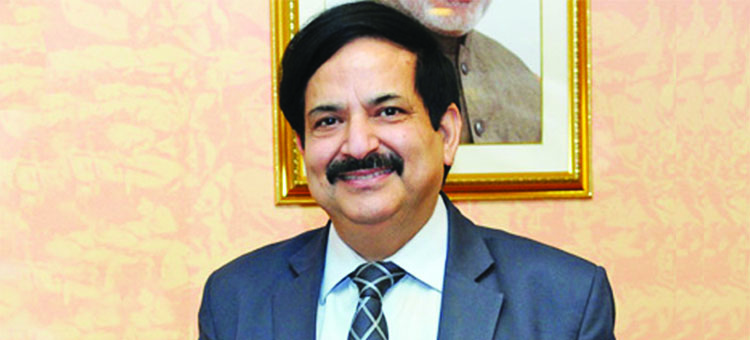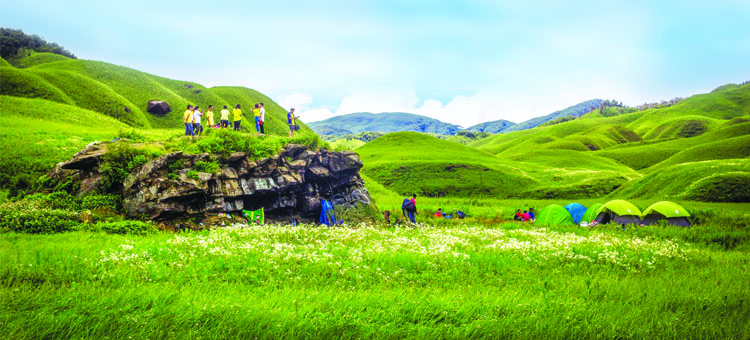Mumbai: North East is blessed with spectacular gift of nature. Comprising the States of Assam, Arunachal Pradesh, Meghalaya, Mizoram, Manipur, Nagaland, Tripura and Sikkim, North East India is a ‘paradise unexplored’ and one of the best destinations for nature lovers, trekkers, adventurers and wildlife enthusiasts.
With vast natural resources, snow-capped Himalayas, tropical forests, shrines of diverse religions, rich traditional values, variety of ethnic tribes and a cauldron of different people and cultures, North East Region provides a wonderful opportunity for exploratory tourism at its very best. Endowed with these natural and cultural resources, it has tremendous potential to emerge as a hotspot destination of Incredible India.
North East Region is a hub of ecotourism; the Himalayan mountains, the Naga, Khasi and Garo hills, the huge waterfalls, the river islands, the national parks, the hill stations, the numerous lakes and the reserved forests are some of the best-known ecotourism spots. North East is also the choicest destination for Adventure Tourism.
The long range of mountains and hills, the deep valleys, the wildlife parks and inland rivers offer a variety of adventure activities like trekking, camping, wildlife safaris, rock climbing, jeep safaris, water rafting, boat safaris and hot air ballooning. The mighty Brahmaputra and a large number of inland rivers are ideal locations for river cruise tourism.
Tawang Monastery in Arunachal Pradesh and the famous Rumtek Monastery in Sikkim are two important destinations for Buddhist Tourism. North East Indian States have the distinction of being the richest in Cultural Tourism vis-a-vis other regions of India.
They offer a mixed culture of Hinduism, Christianity, Islam and Buddhism; have a large number of ethnic groups, with their own unique tribal culture, folk dances, food and crafts.
The region celebrates number of festivals including Bihu of Assam, Hornbill of Nagaland, Sangai of Manipur, Kharchi Puja of Tripura, Torgya Monastery festival of Arunachal Pradesh and Shillong Autumn Festival of Meghalaya. Other USPs of North East Region include Gangtok, the shimmering capital city of Sikkim; Shillong, the quaint town surrounded by rolling hills; Majuli, the cradle of Assam civilization; Tripura, the queen of hills; Cherrapunji, the wettest place in the world; Mizoram, the home of highlanders and Manipur, a musical utopia.
Despite being endowed with everything that a tourist would dream and desire, the tourism potential of the North East still remains untapped and unexplored, primarily because the region has still not been optimally connected to the outside world; there is a huge deficiency of core and tourism infrastructure and that North East is still a lesser-known destination because of insufficient marketing and promotion.
Development of tourism in North East has caught the attention of policy makers in the Government. The sector has started gaining momentum over the last few years
The inflow of both domestic and foreign tourist visits into North East Region is a matter of concern. As per India Tourism Statistics 2017, the total domestic tourist visits during the year 2016 was 77.13 lakh, which was a meagre 0.47 per cent of the total domestic tourist visits within India. The foreign tourist footfall in the region has been no better.
The year 2016 recorded 1.38 lakh foreign tourist arrivals (FTAs) in the region, which was merely 0.55 per cent of the total FTAs into India.
The North Eastern States of Arunachal Pradesh, Mizoram, Nagaland and Sikkim have registered a considerable growth rate in FTAs in 2016 over 2015, ranging from 15 per cent in Arunachal Pradesh to around 18 per cent in Mizoram and Nagaland and more than 70 per cent in Sikkim, however, while Meghalaya and Tripura have grown by around 5 per cent, Assam and Manipur have registered negative growth rates.
The high growth in some of the states may look impressive, however, in terms of absolute number, the overall performance of the region is dismal and very distant from the potential that the region has.
However, development of tourism in North East has caught the attention of policy makers in the Government. The sector has started gaining momentum over the last few years. Connectivity, considered as an inhibitor for tapping the tourism potential of North East, has improved in the recent past.
The second phase of Regional Connectivity Scheme under the National Civil Aviation Policy 2016, includes nine airports and helipads in Arunachal Pradesh, five each in Assam and Manipur and one in Meghalaya. In the list of air routes awarded in the first phase of the scheme, Shillong, Dimapur, Imphal, Silchar, Aizawl and Agartala were connected.
The new airport in Sikkim, is expected to come into operation in due course. The aerodromes at Tezpur, Jorhat and Lilabari in Assam, will have separate civilian enclaves under the Airport Authority of India.
Ministry of Tourism has taken a number of initiatives on all fronts to harness the potential of tourism in the region. These include:
- Developing tourism infrastructure, through its flagship scheme, Swadesh Darshan, in the form of ecotourism, tribal, spiritual, wildlife and North East thematic circuits
- Development of tourism infrastructure in Kamakhya
- Organising international tourism marts, an annual event to highlight the tourism potential of the region in domestic and international markets
- Excluding the entire area of the States of Manipur, Mizoram and Nagaland from Protected Area Permit regime for a period of five years beyond December 31, 2017
- Building inter-regional people-to-people contact between North East India and ASEAN countries, as part of India’s ‘Act East Policy’
- Financial support to North Eastern States for cultural events, publicity, promotion, fairs and festivals
- Familiarisation (FAM) Tours for travel and media representatives to the region under hospitality scheme of the Ministry
- Synergising the process of development of tourism in the region with active participation of Ministry of Development of North Eastern Region (DoNER)
Development of tourism is also one of the priority areas of Ministry of DoNER. The ministry has constituted an Inter-ministerial Committee for tourism sector to coordinate with Tourism, Railways, Road Transport and Civil Aviation ministries.
A new scheme, North East Special Infrastructure Development Scheme (NESIDS) has been launched to develop core infrastructure in North East Region with focus on tourism. The North Eastern Council (NEC), which functions as the Regional Planning Body for the North East Region, extends financial assistance to States and institutions for developing tourism.
Lately, NEC has approved formation of the North Eastern Tourism Development Council on a Public Private Partnership mode to promote regional tourist circuits in the region including collaborations across the borders with Myanmar and Thailand.
The directive of the Central Government to the Ministry of Tourism to spend 10 per cent of its plan allocation in North East Region and the decision of the Government to relax the Leave Travel Concession (LTC) rules to enable Government Servants to travel by air to North East Region on LTC are other important measures taken to augment tourism in the region.
Although, the National Tourism Policy of 2002 speaks little about development of tourism in North East region, however, the Draft National Tourism Policy 2015 has incorporated in its objectives, a clear resolution to focus on development and promotion of the North East.
With this policy initiative of promoting tourism in the region and Ministry of Tourism leading from the front, North East India can look forward to witness a surge in tourism over the next five years.
The massive investments being made by Ministry of Tourism in building tourism infrastructure and by Ministry of DoNER and other ministries in building roads, bridges and improving connectivity by air, rail and waterways will pave the way to boost tourism in the North East Region in coming years.
The region has tremendous potential to attract domestic tourists. The Central Government and the State governments of the region must, therefore, take advantage of the booming domestic tourism sector in the country.
There is also an imminent need to promote the North East Region aggressively. The focus of Government on increasing inter-regional contact with next door nations under its ‘Act East Policy’ is a laudable step that should draw a large number of foreign tourists from South East Asia and East Asia into this region.
(The author is former Secretary, Ministry of Tourism, Government of India. He can be reached at
vinodzutshi@gmail.com)






